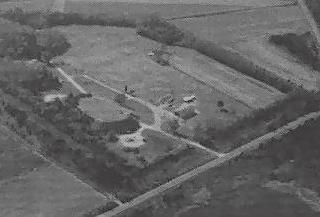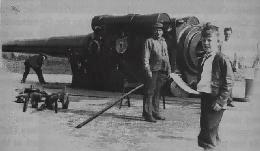|


( All weblinks on this webpage and noted in " Bright Blue ". )
It stands, shrouded in the memories of those still living among the thousands of men who served or were housed there from 1918 through 1945. Fort Saulsbury is located in the very northeast corner of Sussex County, Delaware, six miles east of Milford, adjoining the town of Slaughter Beach. It is the only known fort to be privately owned in the United States. The fort was purchased, and is still owned, by the Kendzierski family in 1948. The U.S. Army approached David W. Shockley and Mark H. Shockley about purchasing their land for use as a fort in 1917. The Army decided that this particular location was the best available to insure protection of the mouth of the Delaware Bay and River from any possible enemy threats during World War I. In 1918 the fort was completed very near the end of WW I. The fort included 4 12-inch guns capable of firing 2,000 pound shells 20 miles and two dirt and grass-covered concrete casements. The casements were constructed of 14 feet thick, steel reinforced concrete with six feet of earth on top for camouflage. The fort was named for Delaware's " U.S. Senator Willard Saulsbury, Sr. " who served in the U.S. Senate from 1859 through 1871 and as Delaware's Attorney General from 1850 through 1855.
The first casemate was named Battery Haslet after Delaware Revoluntionary War Colonel and Sussex County native John Haslet. " Colonel Haslet " was killed during the War on January 3, 1777 during the Battle of Princeton and served under General Washington. The second casemate was named for " Governor David Hall ". David Hall, also a Sussex County native, was with Colonel Haslet during the Revoluntionary War and succeeded him as Colonel of the Delaware Regiment after the death of Colonel Haslet. Colonel Hall was wounded during the Battle of Germantown. Since the fort was completed so close to the end of WW I it was never fully manned. After the armistice in November 1918 the fort was manned by 6 to 8 soldiers with the ranking soldier being a sergeant. When the threat of World War II surfaced changes were made to the fort. First, two of the four 12 inch guns were moved to the newly constructed Fort Miles in Lewes Delaware. Eight new wooden building were erected at Fort Saulsbury to include one as a barracks for officers and three to be used as barracks for enlisted personel. Also constructed was an infirmary, recreation building, company storehouse and an administrative building. This construction took place in 1940.
In May of 1941 the men of the 261st Coast Artillery Battery B, which was originally organized in Georgetown, Delaware, were assigned to Fort Saulsbury for the purposes of coastal defense. They watched the coast line from three steel towers that were built as part of the 1941 restoration. These towers were located at Stone Beach, Mispillion Light and Fowler's Beach. The 261st continued their duty until the completion of Fort Miles at Cape Henlopen in 1942. Then two of the 12 inch guns were sent to Fort Miles and the other two were sent to destinations unknown. The story of Fort Saulsbury didn't end with the dismantling of the guns however. The forts new mission was that of a POW camp for German and Italian soldiers. Hundreds of POW's spent time at Fort Saulsbury until the end of World War II. On January 11, 1946 Fort Saulsbury was deactivated with the last POW leaving. The fort was sold again at a government auction to the Kendzierski family in 1948. The fort was then rented by the Liebowitz Pickle Company for pickle processing and storage. Later it was used as a storage spot for Milford Salvage Company's metal and surplus property. Today Fort Saulsbury remains unused but has once again been sold. At this time I'm not sure what the new owners have planned for the fort ~ " However, they will not allow anyone to trespass on the fort. Experts on American fortifications consider the fort to be the only surviving World War I-era fort which is virtually un-altered and in its primitive state. Many people feel that it is a site which is well worth preserving as a state, and perhaps a national historic landmark. Emanuel R. Lewis, Librarian of the U.S. House of Representatives, in his book " Seacoast Fortifications of the United States, " describes Fort Saulsbury as a classic example of the East Coast fort of the period and worthy of preservation. He wrote : " The only good surviving specimens within the continental limits are two 12 inch gun batteries near Slaughter Beach, Delaware. " Maybe someday, whenever the current owners decide, this forgotten and overlooked fort will finally get some attention and preservation actions will take place.
Story and Page created by :
|
|
|
Email any questions or comments to: Russ Pickett
Last update: 4/7/2007






